The Moon Rabbit
Ever looked at the moon and thought that you could make out the shape of a rabbit on its surface? No? Well many people have, maybe you have a problem. The Moon Rabbit is a mythological figure that appears in various cultures, prominently in East Asian folklore and also in Aztec mythology. In China, the rabbit is one of the twelve celestial animals of the Zodiac.
In Chinese folklore, the Moon Rabbit (also referred to as the Jade Rabbit) is often depicted as a companion to the moon goddess Chang'e, incessantly pounding the elixir of life for her in a mortar and pestle. In Japan and Korea the motif of the rabbit pounding mochi is more popular.
Some of the rabbit's exploits include coming down to Beijing and curing it of a deadly plague and being fought by the Monkey King in the Journey to the West for kidnapping the princess of India and impersonating her, hoping to marry the main protagonist of the novel, Tang Sanzang, to steal his yang essence.
A Buddhist tale on the other hand explains the hare's presence on the moon differently. The ruler of Heaven, Śakra, once disguised himself as a hungry beggar wanting to test the charity of various animals. Knowing only how to fetch grass, the rabbit decided to offer itself as food. Touched by the rabbit's willingness to sacrifice itself, the deity sent it to the moon to live as an immortal being.
The Aztec tale is strikingly similar. The god Quetzalcoatl, who was living on the Earth as a man, started a journey and, in a moment of hunger, thought he would die. A rabbit offered itself as food to save his life. Quetzalcoatl, in gratitude, lifted the rabbit to the sky, showing him the moon, and said, "You may be just a rabbit, but everyone will remember you; there is your image in light, for all men and all times." The Aztec also had a group of four hundred divine rabbits known as Centzon Totochtin who liked getting drunk at parties.
The Cree of Canada have their own story for how the rabbit got on the moon. It was the wish of a rabbit to ride the moon and the crane offered to take him there. The trip stretched out the crane's legs to the proportions we now know.
The Moon Rabbit's legacy has not waned in the Space Age with China's recent moon rovers Yutu and Yutu-2 being named after it. The Moon Rabbit also was the subject of a bit of banter during the Apollo 11 mission:
Houston: Among the large headlines concerning Apollo this morning, is one asking that you watch for a lovely girl with a big rabbit. An ancient legend says a beautiful Chinese girl called Chang-E has been living there for 4,000 years. It seems she was banished to the Moon because she stole the pill of immortality from her husband. You might also look for her companion, a large Chinese rabbit, who is easy to spot since he is always standing on his hind feet in the shade of a cinnamon tree. The name of the rabbit is not reported.
Michael Collins: Okay. We'll keep a close eye out for the bunny girl.
Rabbit in Art
The rabbit's symbolism is a little ambiguous. On the one hand it is a symbol for lust and cowardice, on the other it is a symbol of vitality, fertility and resurrection. The theory that the latter inspired the Easter Bunny is quite popular.
As I will mention in my article on hares it was commonly believed in Antiquity that the hare was a hermaphrodite and could conceive without intercourse, thus keeping its virginity. This would later be associated with the Virgin Mary, with hares and rabbits sometimes featuring along with Mary and Baby Jesus.
A rabbit running from a dog is such a common sight in illuminated manuscripts that it seems to have turned into a meta-joke in its day.
Some see in this a reflection of an innuendo from courtly poetry which used 'cuniculus' as a metaphor for the female sex. In this context the hound becomes the suitor pursuing his beloved.
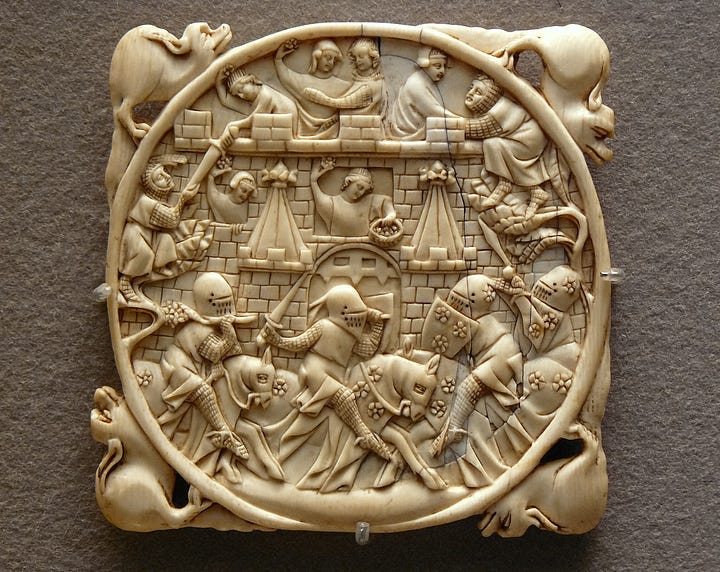
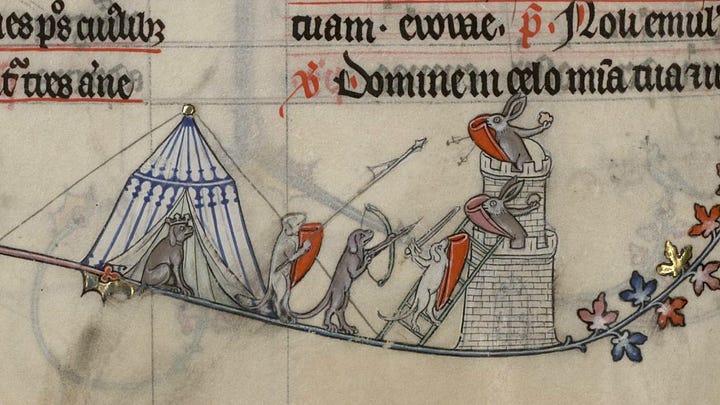
The allegory of the 'château d'amour', a castle defended by women besieged by knights, is sometimes parodied with a castle guarded by rabbits and attacked by dogs. Even Saint Augustine (Confessions 10.35.57) finds himself occasionally distracted by hounds and rabbits during his meditations:
Nevertheless, in how many most minute and contemptible things is our curiosity daily tempted, and who can number how often we succumb? How often, when people are narrating idle tales, do we begin by tolerating them, lest we should give offense unto the weak; and then gradually we listen willingly! I do not now-a-days go to the circus to see a dog chasing a hare; but if by chance I pass such a coursing in the fields, it possibly distracts me even from some serious thought, and draws me after it — not that I turn the body of my beast aside, but the inclination of my mind. And unless You, by demonstrating to me my weakness, speedily warns me, either through the sight itself, by some reflection to rise to You, or wholly to despise and pass it by, I, vain one, am absorbed by it.
Another very interesting rabbit motif in art is that of the three hares/rabbits chasing each other in a circle. It is a religious symbol found in East Asia, the Middle East, Synagogues and in Europe.

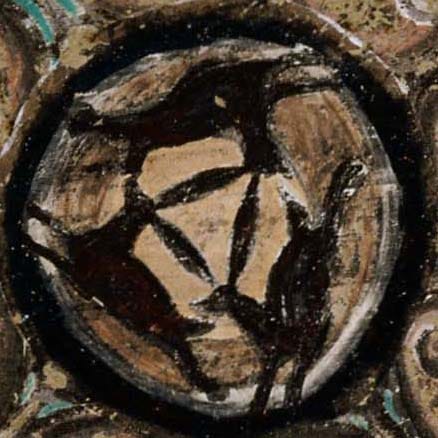
Originating possibly in 6th century China, the motif spread along the Silk Road, appearing in Buddhist, Islamic, and Christian contexts. In Buddhist art, it can be found in cave temples, where it may represent the cyclic nature of life or the interconnectedness of all beings.
In Islamic art, it appears in a variety of decorative contexts without a specific religious connotations.
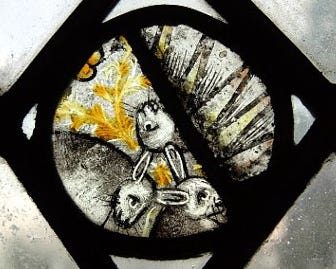
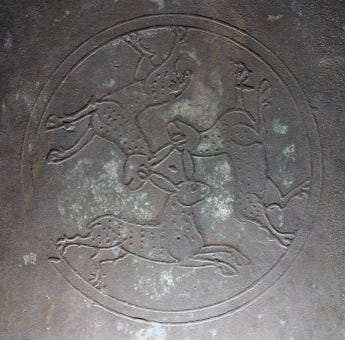
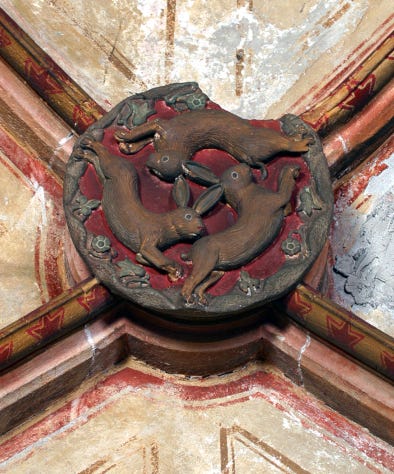
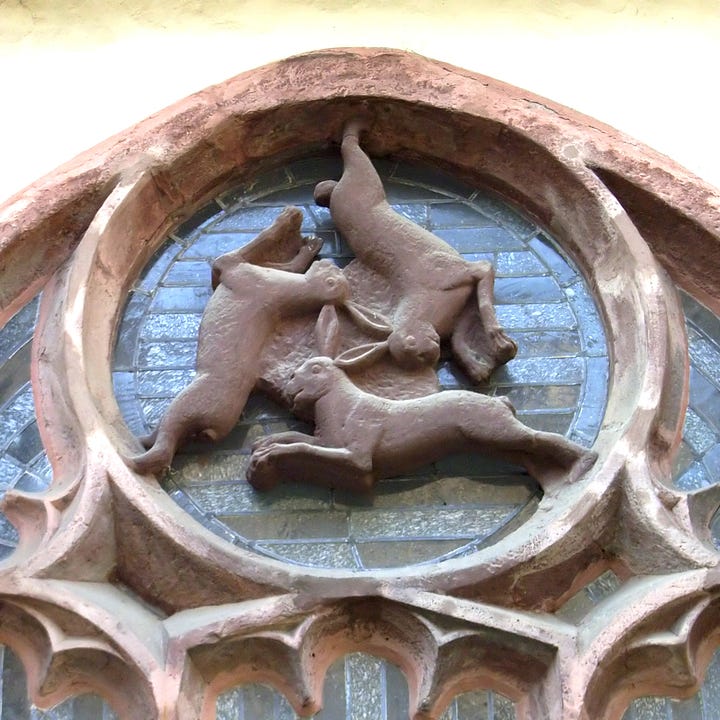
In the medieval era the motif became popular in English and German churches but its meaning is unclear. A good guess is that it represents the Trinity, with the shared ears illustrating the unity of the Father, Son, and Holy Spirit or maybe it is a symbol of fertility and life.
Personally I find it an interesting example of a symbol shared between faiths which all seem to derive mystical or esoteric principles from it.
"Three hares, and three ears, and yet no one has more than two."
The Rabbit in Jewish Tradition
The rabbit is not directly mentioned in the Bible, unless one translates הַשָּׁפָ֗ן as 'coney' (KJV) instead of 'hyrax' (most modern translations). In any case it would be an unclean animal, as is the hare. To find more we have to dig deeper. The Talmud1 expands on (II Chronicles 36:13) where it is said that King Zedekiah (the final King of Judah before the conquest by King Nebuchadnezzar) rebelled against Nebuchadnezzar, who had made him swear by God. What was his vow? According to the Talmud Zedekiah had caught Nebuchadnezzar eating a live rabbit (or hare)!
Greatly ashamed, the King asked Zedekiah to vow to stay silent on this. Zedekiah, so desperate to spread the gossip that it was making him physically suffer had to ask the Sanhedrin to dissolve the vow for him, which they did. Nebuchadnezzar could do little but seethe at being publicly ridiculed.
Popular Beliefs on Rabbits
Scholarship on rabbits in Antiquity is sparse. Pliny2 is of the opinion that they are a species of hare from Spain. They share their name 'cuniculus' with their burrows. Saint Isidore3 posits instead that the name cuniculus derives from the dogs (canis) which seize them.
cuniculi quasi caniculi
Meanwhile, Aelian4 claims that the Greek name (κύνικλος) comes from the Iberians as it is there that the rabbit is the most abundant. He claims they are much more lustful than hares. No matter the time of year, rabbits will go raving mad for females.
In classical literature the rabbit is mostly mentioned in the context of its destructive nature. There are reports by Strabo56 of them causing problems throughout Iberia (the native range of the European rabbit) but particularly the Balearic Islands. This is also reported on by Pliny78. I have talked about the devastation brought by rabbits on the islands in detail in my article on Pliny's accounts of nations destroyed by animals.9
The gist is that the islands on which the rabbits were introduced lacked natural predators which caused a population boom. As Aelian10 states, the rabbit is more lustful than the hare. Mobs of rabbits ravaged local plant life, causing famine, and they burrowed under houses and trees, causing them to be overturned. The situation got so bad that the islanders had to request soldiers from Emperor Augustus and an embassy to Rome for a new place to settle. It is likely that the rabbit started spreading out from Spain throughout Europe thanks to the Romans beginning to domesticate them.
The practice of ferrets being used for hunting rabbits inside their burrows is well attested throughout Antiquity and the Middle Ages. Smoking out the rabbits is not recommended as they are much more likely to simply asphyxiate inside their burrows. If one was lucky enough for the ferrets to leave the new-born (or even unborn) rabbits intact, one could partake in what Pliny11 describes as a most delicate food. Yum! This exact line will offend Edward Topsell some 1600 years later who decries the cruelty of the Roman dish and claims that:
there is no man among Christians so inhumanely gluttonous, as once to devise or approve the sweetness of so foul a dish.
There is however one Balearic Island which is bun free. Pliny12 states that, much like how hares die as soon as they are brought to Ithaca, the same is true for rabbits which are brought to the island of Ebusus (Ibiza).
Aside of being hunted as a pest, rabbits were also used for food and their fur. Rabbit is very low on fat and carbs so has a reputation for being, along with other lean meats, poor survival food, causing protein poisoning. Appian (Wars in Spain 9.54) gives us an account of a Roman army camp suffering from the effects of rabbit starvation:
This victory raised the spirits of the Romans, but the next night they were seized with panic. A body of the enemy's horse who had gone out foraging before Lucullus arrived, returned and not finding any entrance to the city because it was surrounded by the besiegers, ran about shouting and creating disturbance while those inside the walls shouted back. These noises caused strange terror in the Roman camp. Their soldiers were sick from want of sleep, and because of the unaccustomed food which the country afforded. They had no wine, no salt, no vinegar, no oil, but lived on wheat and barley, and the flesh of deer and rabbits boiled without salt, which caused dysentery, from which many died.
Rabbit/Hare meat being less nutritious as most other meats was known to the Romans as Celsus13 rated it as such in his medical treatise. In the Middle Ages rabbit meat was not considered particularly noble and was consumed by all classes. It being easy to poach certainly helped. According to Topsell14 tame rabbit meat is of lesser quality than that of wild rabbits and the Spaniards do not eat it. This is because creatures taste of the air in which they live and rabbits kept in captivity live close to their excrement in worse air than the air enjoyed by rabbits who are able to run wild.
The use of a rabbit's foot as a good luck amulet is well known in modern America, with some attributing African American folk magic as its origin. The first mention I could find of such an amulet being used dates back to Roman times. Pliny15 talks about people carrying a hare's foot with them to help with gout. He does specify the foot has to be cut off from a live animal though.
The rabbit seems to be a little uncommon in Medieval Bestiaries. Thomas of Cantimpré16 restates the rabbit's penchant for multiplying too much and destruction, especially in vineyards. This is interesting because rabbits/hares were very often depicted enjoying grapes on Roman mosaics. He does tell us something new though, rabbits stomp their feet when hearing a suspicious noise and they are capable of levelling the mouth of their burrow with dust to hide it.
I will end this with the story of Mary Toft, an English woman who in 1726 miscarried after seeing a rabbit. After her miscarriage she began birthing more or less complete rabbit abominations and later other odd bits and pieces such as eel bones as well as cat guts and legs. The English public, understandably, went nuts for this with physicians in particular hoping for the fame and money which would come from documenting and explaining such a phenomenon. They all observed her birthing rabbit parts and became themselves convinced of the legitimacy of her condition. The story became so big that King George I got involved and sent a skeptical surgeon to investigate. It turned out she was shoving pieces of animals up her uterus. Mystery solved. This became a massive scandal and everyone involved got mercilessly mocked. The End.
The Gemara cites another proof that one may dissolve such a vow or oath only in the presence of the party affected by the vow or oath. It states with regard to King Zedekiah: “And he also rebelled against King Nebuchadnezzar, who had made him swear by God” (II Chronicles 36:13). The Gemara asks: What was his rebellion? The Gemara answers: Zedekiah found Nebuchadnezzar eating a live rabbit, and the latter was ashamed to be seen doing this. He said to him: Take an oath to me that you will not reveal my behaviour and this matter will not emerge in public. Zedekiah took an oath to him. Later, Zedekiah was physically suffering, as he wanted to tell people what he had seen, but he could not do so due to his oath. He requested dissolution of his oath from the judges of the Sanhedrin, who dissolved it for him, and he publicly said what he had witnessed. Nebuchadnezzar heard that he was being ridiculed for his behaviour. He sent for and brought the Sanhedrin and Zedekiah before him. He said to them: Did you see what Zedekiah has done? Did he not take an oath in the name of Heaven: That I will not reveal? They said to him: He requested dissolution of the oath. He said to them: Can one request the dissolution of an oath? They said to him: Yes. He said to them: Must this be done in the presence of the person he took an oath to, or even not in his presence? They said to him: It must be dissolved in his presence. He said to them: And you, what did you do? What is the reason you did not say to Zedekiah that he can have his oath dissolved only in my presence? Immediately, they fulfilled the verse: “They sit upon the ground, and keep silence, the elders of the daughter of Zion” (Lamentations 2:10). Rabbi Yitzḥak said: This means that they removed the cushions upon which they sat from underneath them, as a sign that they had erred in halakha.
Nedarim 65a
There is also a species of hare, in Spain, which is called the rabbit; it is extremely prolific, and produces famine in the Balearic islands, by destroying the harvests. The young ones, either when cut from out of the body of the mother, or taken from the breast, without having the entrails removed, are considered a most delicate food; they are then called laurices. It is a well-known fact, that the inhabitants of the Balearic islands begged of the late Emperor Augustus the aid of a number of soldiers, to prevent the too rapid increase of these animals. The ferret is greatly esteemed for its skill in catching them. It is thrown into the burrows, with their numerous outlets, which the rabbits form, and from which circumstance they derive their name, and as it drives them out, they are taken above.
Pliny the Elder, Natural History, 8.81
Rabbits [cuniculus], a type of field animal, are so called as if the word were caniculus, because they are seized or driven out of their holes by hunting packs of dogs [canis].
Isidore of Seville, Etymologies, 12.1.24
There is also another kind of hare, small by nature, and it never grows larger. It is called a rabbit {cuniculus}. I am no inventor of names, which is the reason why in this account I preserve the original name given to it by the Iberians of the west in whose country the Rabbit is produced in great numbers. Its colour compared with that of hares is dark; it has a small tail, but in other respects it is like them. A further difference is in the size of its head, for it is smaller and curiously scant of flesh and shorter. But it is more lustful than the hare <it is by nature incontinent throughout the year> which cause it to go raving mad when it goes after the female.
Aelian, On Animals, 13.15
Turdetania also has a great abundance of cattle of all kinds, and of game. But there are scarcely any destructive animals, except the burrowing hares, by some called "peelers"; for they damage both plants and seeds by eating the roots. This pest occurs throughout almost the whole of Iberia, and extends even as far as Massilia, and infests the islands as well. The inhabitants of the Gymnesian Islands [i.e. the Balearic Islands of Mallorca and Menorca], it is said, once sent an embassy to Rome to ask for a new place of abode, for they were being driven out by these animals, because they could not hold out against them on account of their great numbers. Now perhaps such a remedy is needed against so great a warfare (which is not always the case, but only when there is some destructive plague like that of snakes or field-mice), but, against the moderate pest, several methods of hunting have been discovered; more than that, they make a point of breeding Libyan ferrets, which they muzzle and send into the holes. The ferrets with their claws drag outside all the rabbits they catch, or else force them to flee into the open, where men, stationed at the hole, catch them as they are driven out.
Strabo, Geography, 3.2.6
In addition to the fruitfulness of the soil, there is also the fact that no injurious animal can easily be found in the Gymnesiae. For even the rabbits there, it is said, are not native, but the stock sprang from a male and female brought over by some person from the opposite mainland; and this stock was, for a fact, so numerous at first, that they even overturned houses and trees by burrowing beneath them, and that, as I have said, the people were forced to have recourse to the Romans. At present, however, the ease with which the rabbits are caught prevents the pest from prevailing; indeed, the landholders reap profitable crops from the soil.
Strabo, Geography, 3.5.2
See note 2
Nor are there less remarkable instances of destructiveness even in the case of contemptible animals. Marcus Varro states that a town in Spain was undermined by rabbits and one in Thessaly by moles, and that a tribe in Gaul was put to flight by frogs and one in Africa by locusts, and the inhabitants were banished from the island of Gyara in the Cvclades by mice, and Amynclae in Italy was completely destroyed by snakes. North of the Ethiopic tribe of the Bitch-milkers there is a wide belt of desert where a tribe was wiped out by scorpions and ‘solipuga’, and Theophrastus states that the Rhoetienses were driven away by a kind of centipede.
Pliny the Elder, Natural History, 8.43
Pliny the Elder's Account of Nations Destroyed by Animals.
In the West, awareness of stories involving animals ravaging human settlements is usually limited to a few accounts in the Bible: plagues of frogs, locusts, lice and vermin in Egypt and the foreign nations slain by lions in Samaria.
See Note 4
See Note 2
When hares have been brought to Ithaca, they die as soon as ever they touch the shore, and the same is the case with rabbits, on the shores of the island of Ebusus; while they abound in the vicinity, Spain namely, and the Balearic isles.
Pliny the Elder, Natural History, 8.83
So then it should be known that all pulses, and all bread-stuffs made from grain, form the strongest kind of food (I call strongest that which has most nourishment). To the same class of further belong: all domesticated quadruped animals; all large game such as the wild she-goat, deer, wild boar, wild ass; all large birds, such as the goose and peacock and crane; all sea monsters, among which is the whale and such like; also honey and cheese. Hence it is not wonderful that pastry made of grain, lard, honey and cheese is very strong food. Among food materials of the middle class ought to be reckoned: of pot-herbs, those of which the roots or bulbs are eaten; of quadrupeds, the hare; birds of all kinds from the smallest up to the flamingo; likewise all fish which do not bear salting or are salted whole. The weakest of food materials are: all vegetable stalks and whatever forms on a stalk, such as the gourd and cucumber and caper, all orchard fruits, olives, snails, and likewise shellfish.
Celsus, De Medicina, 2.18
but the tame ones are not so good, for in Spain they will not eat of a tame Cony, because every creature doth partake in tast of the air wherein he liveth, and therefore tame Conies which are kept in a close and unsweet air, by reason of their own excrements, cannot tast so well, or be so wholesome as those which run wilde in the mountains and fields, free from all infection of evill air.
Edward Topsell, The History of Four-footed Beasts, p.87
Gout, they say, may be allayed by the patient always carrying about with him a hare's foot, cut off from the animal alive.
Pliny the Elder, Natural History, 28.62
The rabbit is a small beast, almost similar in colour and shape to the hare. This beast digs up the earth in its burrow dwellings and demolishes the vineyard as much as possible, grazing the vines and the crops at night. But in the morning, when it enters the burrow, the mouth of the burrow is levelled with dust throughout the interior, so that people coming over may not discover its dwelling during the day. Wherever they live, they multiply too much; for they give birth several times a year. When some of the rabbits feel something adverse in the place where they live, others flee. And without delay, the rest of the rabbits leave the place with them and flee. For they are of innumerable fertility. As they gather together to graze, if they hear anything suspicious, they strike the ground with their feet, and then they all cower with lowered heads.
Thomas of Cantimpré, Quadrupeds, 4.25




























